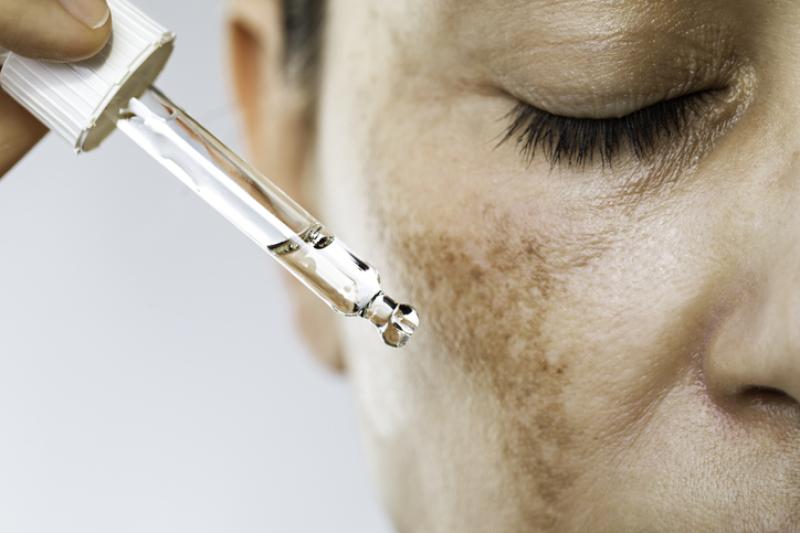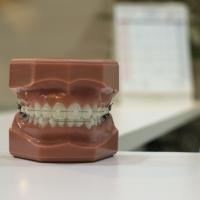Home > Blog > Skin and Body
The Melasma Manual: Everything You Need to Know

You've probably seen it before, even if you didn't know the name. Those dark, discoloured patches sometimes appear on people's faces, causing them to feel self-conscious and frustrated. It's called melasma, and it's a common skin condition that affects millions of people around the world.
Melasma is characterized by dark, irregular patches on the skin, typically on the face. These patches can vary in size, shape, and colour but are generally brownish-gray. The condition is more common in women, particularly those with darker skin tones, although men can also be affected. While melasma is not dangerous or contagious, it can be difficult to treat, and many people struggle to find a solution that works for them.
By learning everything you need to know about melasma, you can see the various melasma treatment options available to find the best solution for you.
Causes of Melasma
Melasma is a complex condition, and researchers are still working to understand its causes fully. However, it's generally thought to be the result of several factors, including:
- Hormonal changes: Fluctuations in hormones, particularly estrogen and progesterone, are believed to play a significant role in the development of melasma. It's why the condition is more common in women, especially during pregnancy, when hormone levels change dramatically. Hormone therapy and birth control pills can also contribute to melasma.
- Sun exposure: Ultraviolet (UV) radiation from the sun can trigger melasma by causing an overproduction of melanin, the pigment responsible for skin colour. That's why melasma often worsens during the summer months and improves in the winter when there is less sunlight.
- Genetics: Some people may be more prone to developing melasma due to their genetic makeup. You may be at an increased risk if you have a family history of the condition.
- Skin irritation: Certain skin care products or treatments can irritate the skin and trigger melasma, especially if they cause inflammation or an allergic reaction.
Understanding the underlying causes of melasma can help you take steps to prevent it and choose the most effective treatment options for your specific needs.
Types of Melasma
There are three main types of melasma, classified based on the location and depth of the pigmentation in the skin. Knowing which type you have can help you and your healthcare provider determine the most appropriate melasma treatment plan for you.
- Epidermal melasma: This type of melasma affects the outermost layer of the skin, known as the epidermis. The pigmentation in epidermal melasma is usually well-defined and has a dark brown colour. It is the easiest to treat, as the pigmentation is closer to the skin's surface.
- Dermal melasma: This type affects the deeper layers of the skin, specifically the dermis. The pigmentation in dermal melasma is less defined and has a blue-gray colour. Dermal melasma is more difficult to treat, as the pigmentation is deeper within the skin.
- Mixed melasma: As the name suggests, mixed melasma combines both epidermal and dermal melasma. It is the most common type and can be challenging to treat, as it involves pigmentation at different depths within the skin.
Symptoms & Diagnosis of Melasma
The primary symptom of melasma is the appearance of dark, discoloured patches on the skin. These patches are usually symmetrical, meaning they appear on both sides of the face and are most commonly found on the cheeks, forehead, nose, and upper lip. In some cases, melasma may also appear on other body parts exposed to the sun, such as the arms and neck.
To diagnose melasma, a healthcare provider will usually examine your skin and ask about your medical history, including any medications you're taking and your exposure to the sun. In some cases, they may use a special device called a Wood's lamp to examine your skin more closely and determine the depth of the pigmentation.
If your healthcare provider suspects that an underlying medical condition or medication may cause your melasma, they may recommend additional tests or a consultation with a specialist.
How to Prevent Melasma
Protecting your skin from the sun is one of the most effective ways to prevent melasma. These include:
- Wearing sunscreen: Apply a broad-spectrum sunscreen with an SPF of 30 or higher every day, even if it's cloudy or you're staying indoors. Remember to reapply every two hours, especially if swimming or sweating.
- Seeking shade: Whenever possible, seek shade outdoors, particularly during the peak sun hours of 10 a.m. to 4 p.m.
- Wearing protective clothing: Wear wide-brimmed hats, sunglasses, and long sleeves to shield your skin from the sun's harmful rays.
In addition to sun protection, you should also be mindful of the products you use on your skin, as some can cause irritation and trigger melasma. Opt for gentle, fragrance-free products that are specifically formulated for sensitive skin. If you're taking hormone therapy or birth control pills and are concerned about melasma, talk to your healthcare provider about your options. They may recommend alternative methods of contraception or adjust your hormone therapy to help reduce your risk.
Melasma Treatment Options
There is no one-size-fits-all solution for treating melasma, as the condition can be stubborn and resistant to treatment. However, various options are available, ranging from over-the-counter products to professional treatments and natural remedies. Being patient and persistent with your melasma treatment is essential, as it may take time to see results.
Over-The-Counter Melasma Treatments
Over-the-counter (OTC) products are usually the first line of defence against melasma. These treatments can help lighten the pigmentation and improve the appearance of your skin. Some popular OTC melasma treatments include:
- Topical lightening agents: Products containing hydroquinone, glycolic acid, kojic acid, or azelaic acid can help to fade dark patches by inhibiting melanin production. Always follow the product's instructions, and consult your healthcare provider if you experience any adverse reactions.
- Retinoids: Retinoids, such as retinol, can help to exfoliate the skin and promote cell turnover, which can improve the appearance of melasma. Be sure to start with a low concentration and gradually increase as your skin becomes more tolerant.
- Chemical peels: At-home chemical peels containing alpha hydroxy acids (AHAs), such as glycolic acid, can help to remove the top layer of dead skin cells and reveal a brighter, more even complexion.
Professional Medical Aesthetic Melasma Treatments
If OTC treatments aren't providing the desired results, consider professional melasma treatments. A dermatologist or licensed esthetician typically performs these procedures and can be more effective than OTC options. Some professional melasma treatments include:
- Chemical peels: In-office chemical peels use stronger concentrations of AHAs or other acids to remove the top layer of skin and reveal a more even complexion.
- Microdermabrasion: This procedure involves using a machine to exfoliate the skin's surface and remove dead skin cells, which can help improve melasma's appearance.
- Laser therapy: Lasers can target the pigmented areas of your skin and break down the melanin, which your body can then absorb and eliminate. However, laser therapy can be expensive and unsuitable for all skin types.
Natural Remedies for Melasma
Natural remedies can also help improve melasma's appearance, although they may not be as effective as OTC or professional treatments. Some natural remedies to consider include:
- Aloe vera: Aloe vera contains a compound called aloin, which may help to lighten pigmentation. Apply aloe vera gel to the affected areas twice daily for best results.
- Turmeric: Turmeric has been used for centuries as a natural skin-lightening agent. Mix a small amount of turmeric powder with water or yogurt to create a paste, and apply it to the affected areas for 20 minutes before rinsing.
- Lemon juice: The citric acid in lemon juice can help to exfoliate the skin and reduce pigmentation. Apply fresh lemon juice to the affected areas and rinse after 10 minutes. Avoid sun exposure after using lemon juice, as it can make your skin more sensitive to the sun.
Maintaining Your Skin After Melasma Treatment
Once you've found a melasma treatment that works for you, it's important to maintain your skin to prevent the condition from returning. That includes:
- Continuing sun protection: Even after your melasma has improved, you should continue to protect your skin from the sun to prevent it from returning.
- Using gentle skincare products: Opt for gentle, fragrance-free products designed for sensitive skin to avoid irritation and potential triggers.
- Monitoring your skin: Keep an eye on your skin and be aware of any changes in pigmentation. If your melasma returns, consult your healthcare provider to discuss your treatment options.
Cosmetic Melasma Solutions
If you're looking for a more immediate solution for your melasma, cosmetic solutions may be an option to consider. These treatments can help to reduce the appearance of dark spots and even out your skin tone. Some cosmetic treatments for melasma include:
- Makeup: Using makeup products like concealers, colour correctors, and foundations can help cover up melasma patches and even your skin tone. Look for products specifically designed for melasma-prone skin, and choose shades that match your skin tone.
- Camouflage creams: Camouflage creams are highly pigmented and designed to cover skin discoloration, including melasma. These creams are usually waterproof and long lasting, making them an excellent option for special occasions or when you need more coverage.
- Microblading: Microblading is a semi-permanent makeup technique that involves tattooing tiny, hair-like strokes onto your skin to create the appearance of fuller, more defined eyebrows. It can be a great option if your melasma has affected your eyebrows, causing them to appear sparse or patchy.
Melasma can be a frustrating and challenging condition to deal with, but many treatment options are available to help improve its appearance. If you're struggling with melasma, don't be afraid to seek help from a healthcare provider or licensed skincare professional. They can help you determine the underlying causes of it and recommend a melasma treatment plan that works for you. With the right treatment and care, you can reduce the appearance of your melasma and feel confident in your skin again.
More to Read:
Previous Posts:






